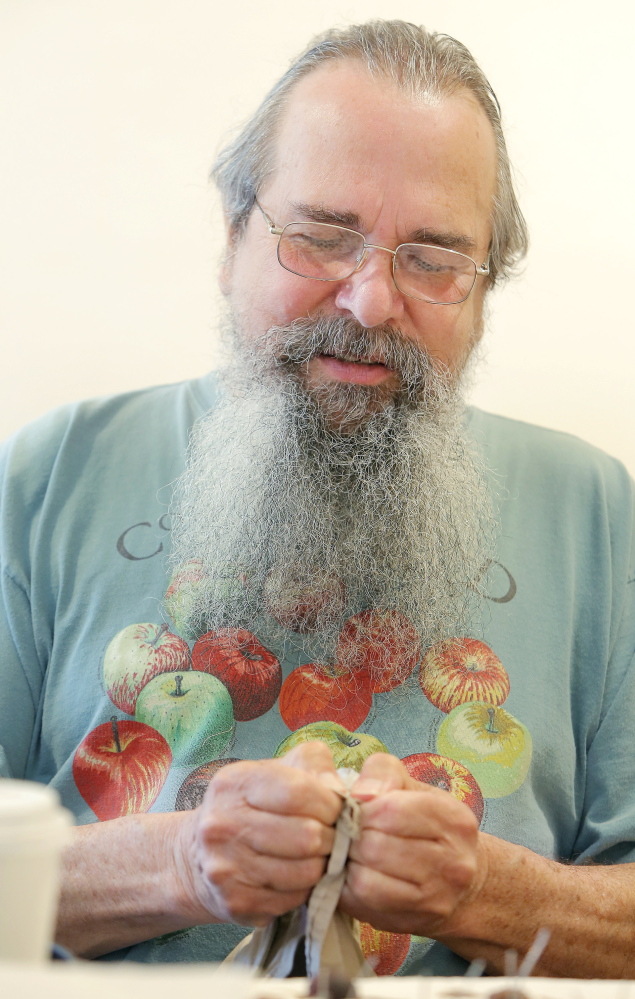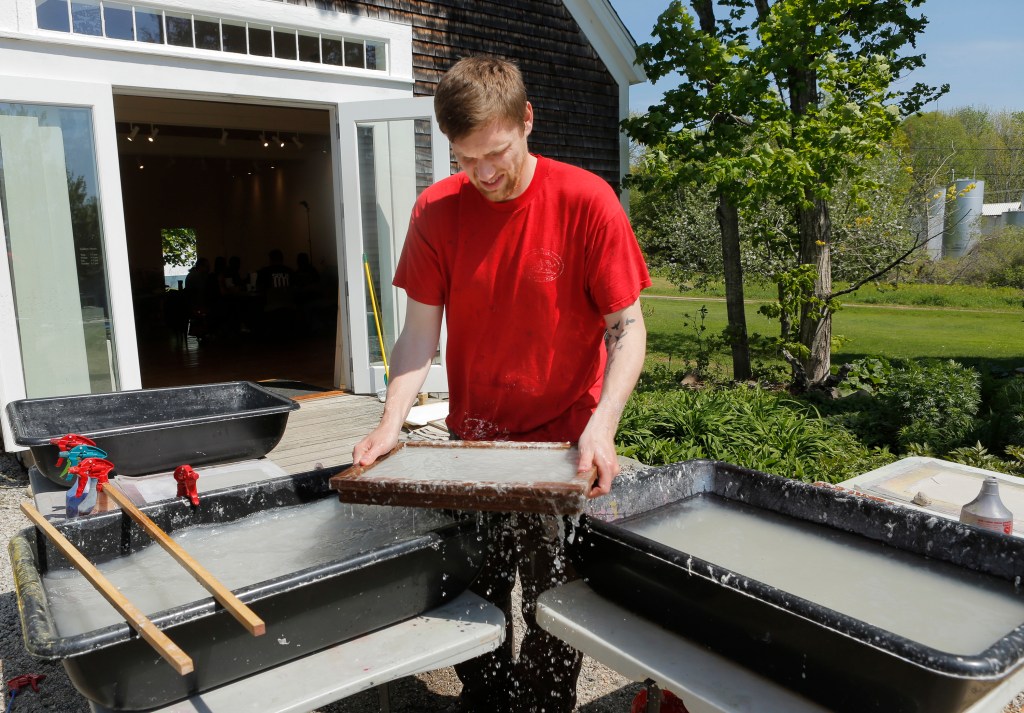DEER ISLE — Terry Grasse took one step closer to normal this week. As he sat in the quiet stillness of a sun-filled Deer Isle morning and shredded pieces of an old Army uniform, the artist and poet felt decades of post-traumatic stress slip away.
“Letting go, you can’t really put a name on it,” said Grasse, who lives in Lisbon Falls. “But you feel comfortable. It’s another step toward being normal. This is a way to share and a way to let go of a few things.”
Forty-seven years after coming home from Vietnam, Grasse, 68, joined other veterans from around the country, and from different wars, to make paper from old combat uniforms this week at Haystack Mountain School of Crafts. With that paper, they created artwork that will hang on the walls of Haystack’s Center for Community Programs in Deer Isle, beginning Friday night and running through Sunday.
This is the third year that Haystack has hosted the Combat Paper workshop, and it’s the final effort of longtime Haystack director Stuart Kestenbaum, who retires this week. The 2015 program is funded by a $12,000 grant from the Maine Community Foundation, Kestenbaum said. Before finishing his work at Haystack, he secured funding through the Windgate Charitable Foundation to continue the program for another two years.
“This one is really important to me,” he said. “I wanted to be sure that I stayed to see it through.”
This sort of program has become a hallmark of Kestenbaum’s 27-year tenure as Haystack director. It’s innovative and unusual, and incorporates traditional art-making with contemporary expression. It also targets a diverse group of artists.
“We’re artists making work, and we happen to be veterans,” said one of the workshop leaders, Eli Wright, an Army veteran who was in the Iraq War. “We’re creating a new language to talk about war.”
SHARING STORIES, HEALING TOGETHER
For this project, Haystack collaborates with Combat Paper NJ, a veteran-run art project that has been turning veterans’ service uniforms into paper since 2011. It employs an ancient technique of turning fiber into pulp, and then into paper.
Using a variety of printmaking approaches, the artists express themselves with messages on the paper about their experiences in war. There’s also a writing component to the program, for veterans who prefer expressing themselves with words.
It began with a veteran-artist in Vermont, who hooked up with David Keefe, a former Marine and Iraq War veteran who teaches painting and other art skills at Montclair State University in New Jersey. With support from the Printmaking Center of New Jersey, the movement has spread around the country, with Haystack emerging as an epicenter in the Northeast.
At Haystack, the program evolved from a two-day demonstration three years ago to a weeklong workshop that draws veteran-artists from around the country. About half of the 30 participants this week are from Maine.
Driving up to Deer Isle from Lisbon Falls, Grasse stopped in a second-hand store in Searsport. He picked up ceiling tin, tin snips and sandpaper for $20. Grasse snipped the tin into strips and star shapes, and smoothed the edges with sandpaper. He pressed the shaped tin between sheets of paper to create a multimedia wall-hanging that resembles the U.S. flag.
Grasse is interested in seeing how the rust of the tin wears on the paper, and how the piece evolves with time, as well as the emotions and reactions it evokes.
Art-making is important here, Grasse said. But so is the opportunity for veterans to congregate around a common activity. During those moments when they work side by side, they share stories. There are conversations over lunch, at night. For many of the men and women who sign up for Combat Paper, it’s the first time they’ve come together as a community to talk about their experiences of war and its aftermath.
“It’s not so much what I accomplish here, but what I feel and what happens here,” said Grasse, who also writes poetry. “It took a long time as a Vietnam vet to come back. Coming to an event like this is part of that process. It’s a way to share and a way to let go of a few things.”
USING ART TO EXPRESS FEELINGS ABOUT WAR
A few feet away from where Grasse worked, another Maine veteran, Debe Loughlin of Waldoboro, created a ladder structure with wire, which she pressed between pieces of paper. Loughlin, long associated with the University of Southern Maine’s art department, served in the Coast Guard for six years in the 1970s. She did not see combat, but participated in many dangerous drug busts, pulled dead bodies from the water, and suffered related trauma and stress. She rarely talked about her experiences. Many of her USM colleagues didn’t know she served, Loughlin said.
A few years ago, her son became the third generation in her family to serve in the military. He was sent to Iraq without a flak jacket, which upset Loughlin. She worried about his well-being and was frustrated that the military had instructed her son to do a job without the proper equipment. As an artistic expression, she made a symbolic life jacket, which received national attention.
That was the first time Loughlin used her art to express her feelings about war and the military. “That’s when this all started. That’s when I realized that I’ve got something to say,” she said.
In the years since, she has taken on the responsibility of installing art at the Portland Vets Center on Stevens Avenue in Portland. She will hang an exhibition there next week, with an opening scheduled for June 5.
The week at Haystack has been cathartic, Loughlin said. She brought the last Coast Guard uniform that she still owned, a summer dress. Loughlin, 62, called the snipping of the uniform into postage stamp-size pieces “an amazingly emotional experience. After I started doing it, I thought about all those years I wore this uniform and how it changed my life – for good and bad. It’s very complicated, and it’s never talked about.”
Wright, one of the workshop facilitators from New Jersey, likes the idea of using an ancient art form to talk about complicated, contemporary issues. Haystack is the perfect place to do it, he said, because it encourages innovation and adaptive art-making techniques.
Wright hopes people who see the art this weekend do not get distracted by the veteran status of the art-makers.
“This is not a feel-good story about broken veterans,” he said. “We are not seeking sympathy.”
Send questions/comments to the editors.











Success. Please wait for the page to reload. If the page does not reload within 5 seconds, please refresh the page.
Enter your email and password to access comments.
Hi, to comment on stories you must . This profile is in addition to your subscription and website login.
Already have a commenting profile? .
Invalid username/password.
Please check your email to confirm and complete your registration.
Only subscribers are eligible to post comments. Please subscribe or login first for digital access. Here’s why.
Use the form below to reset your password. When you've submitted your account email, we will send an email with a reset code.